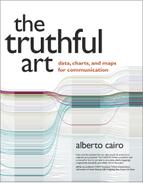Acknowledgments
I always chuckle when someone calls me an “expert” on visualization or infographics. As a journalist, I’ve made a profession of being an amateur, in the two senses of the word: someone who doesn’t have a deep understanding of anything, but also someone who does what he does due to unabashed love for the craft.
This book is a tribute to that second kind of amateur, folks who bring good data to the world in a time when society is drowning in tsunamis of spin and misinformation. They know that it is possible to change the world for the better if we repeat the truth often and loud enough.
I’d like to first thank my University of Miami (UM) colleague Rich Beckman. It’s not an exaggeration to say that I wouldn’t be where I am today without his help, advice, and mentorship.
Seth Hamblin, a friend at The Wall Street Journal, passed away while I was writing this book. Seth was in love with infographics and visualization. When I told him about The Truthful Art, he got as excited as a kid. He was a beautiful human being, and he’ll be missed.
To Greg Shepherd, dean of UM’s School of Communication; Nick Tsinoremas, director of UM’s Center for Computational Science (CCS); Sawsan Khuri, also from CCS, a great colleague and better friend; Sam Terilli, head of our department of journalism; and Kim Grinfeder, who leads our Interactive Media program. Also at UM, I’d like to thank my colleagues in the departments of Journalism and Interactive Media, and at the Center for Communication, Culture, and Change.
To Phil Meyer, whose book Precision Journalism inspired me many years ago. In fact, I wrote The Truthful Art with the goal of being a Precision Journalism for the new century.
To my past colleagues at La Voz de Galicia, Diario16, DPI Comunicación, El Mundo, and Editora Globo. Among them, Helio Gurovitz, the former managing editor at Globo’s Época magazine, who combines a deep knowledge of journalism with an unusual sensibility of how to use numbers and graphics.
Also, to my clients and partners worldwide, particularly Jim Friedland, for all his support in the past two years.
Many people read this book while it was in the works. My editor, Nikki McDonald, and my copyeditor, Cathy Lane, kept an eye on me at all times, and did their best to make me meet deadlines (they failed).
Stephen Few sent me detailed notes about each chapter. Steve is both a friend and arguably my most severe critic. I’ve done my best to incorporate as much from his feedback as possible, but not all. I know that Steve will still disagree with some of my musings, but those disagreements can be great topics to ponder while enjoying some fine wine and cheese.
Erik Jacobsen also provided detailed feedback. His notes have been invaluable.
Three statisticians, Diego Kuonen, Heather Krause, and Jerzy Wieczorek, read the most technical chapters and made sure that I was not writing anything particularly silly. Others who commented on the book are: Andy Cotgreage, Kenneth Field, Jeff Jarvis, Scott Klein, Michael E. Mann, Isabel Meirelles, Fernanda Viégas, Martin Wattenberg, and Sisi Wei. Thank you all.
Thanks also to all the individuals and organizations who let me showcase their work in The Truthful Art. You’re too numerous to mention, but you’ll see your names in pages to come.
Some of my followers on Twitter volunteered for the last round of proofreading. They are: Mohit Chawla, Fernando Cucchietti, Stijn Debrouwere, Alex Lea, Neil Richards, Frédéric Schütz, and Tom Shanley.
Special thanks to Moritz Stefaner, for giving me permission to use one of his amazing graphics on the cover of this book.
To Nancy.
Finally, and above all, thanks to my family.
About the Author
Alberto Cairo is the Knight Chair in Visual Journalism at the School of Communication of the University of Miami (UM), where he heads specializations in infographics and data visualization. He’s also director of the visualization program at UM’s Center for Computational Science, and Visualization Innovator in Residence at Univisión.
He is the author of the books Infografía 2.0: Visualización interactiva de información en prensa, published just in Spain in 2008, and The Functional Art: An Introduction to Information Graphics and Visualization (New Riders, 2012).
In the past two decades, Cairo has been director of infographics and visualization at news organizations in Spain and Brazil, besides consulting with companies and educational institutions in more than 20 countries. He also was a professor at the University of North Carolina-Chapel Hill between 2005 and 2009.
Cairo’s personal weblog is www.thefunctionalart.com. His corporate website is www.albertocairo.com.
His Twitter handle is @albertocairo.
Additional Materials
I designed many of the charts and maps you’re about to see in The Truthful Art, but I haven’t written much about the software I used to create them. If you’re interested in learning about tools, please visit my weblog, www.thefunctionalart.com, and go to the Tutorials and Resources section on the upper menu.
There, you will find several articles and video lessons I recorded about programs and languages like R, iNzight, and Yeeron, among others.
